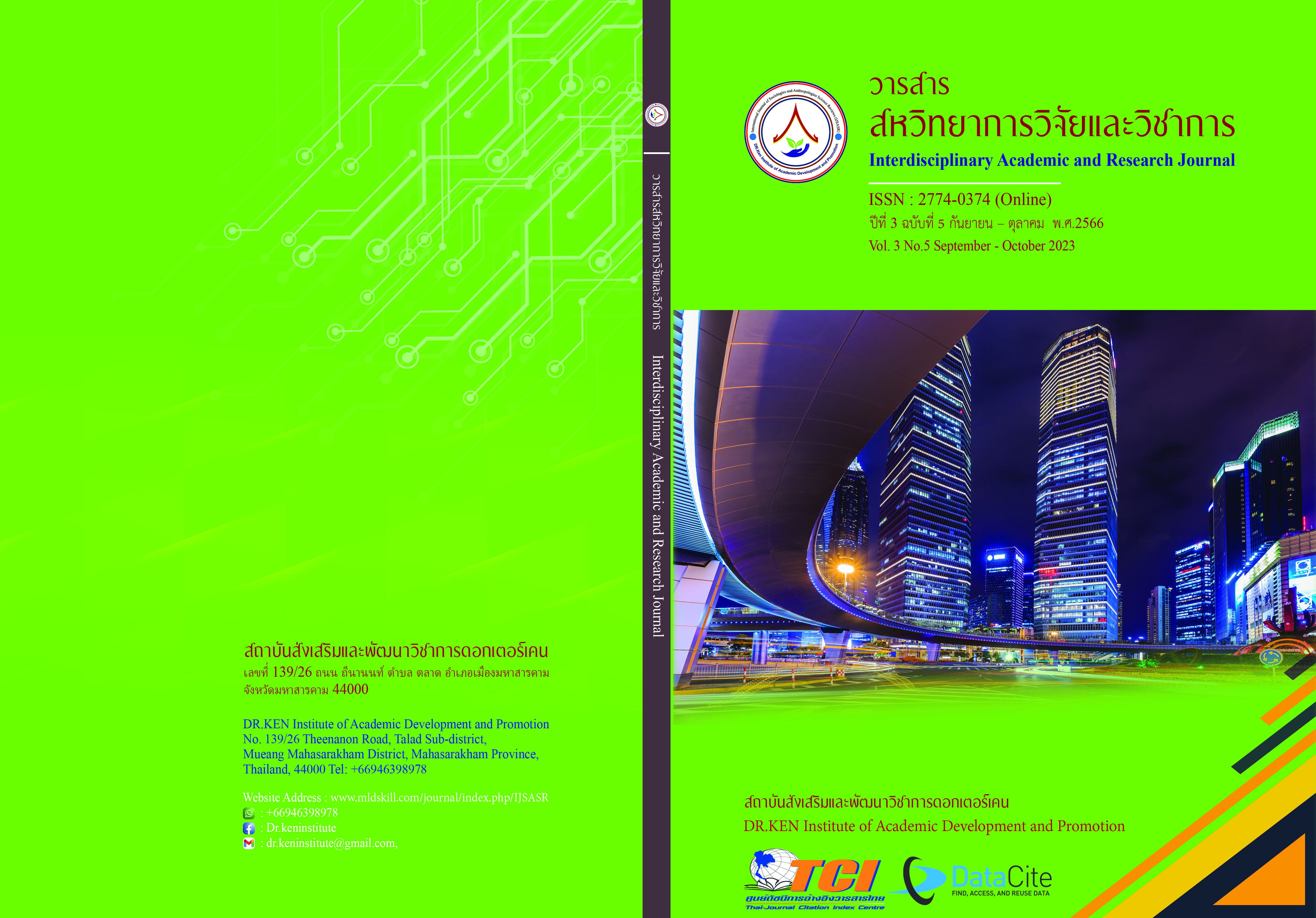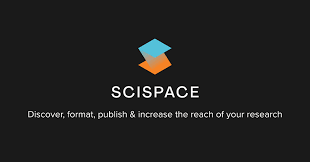การจัดการเรียนรู้โดยใช้ปัญหาเป็นฐานร่วมกับการใช้ผังกราฟิกเพื่อพัฒนาสมรรถนะในการแก้ปัญหาแบบร่วมมือและผลสัมฤทธิ์ทางการเรียนสำหรับนักเรียนชั้นมัธยมศึกษาปีที่ 5 เรื่อง การสังเคราะห์ด้วยแสง
DOI:
https://doi.org/10.14456/iarj.2023.262คำสำคัญ:
แผนผังกราฟิกการจัดการเรียนรู้โดยใช้ปัญหาเป็นฐานร่วมกับผังกราฟิก; , สมรรถนะในการแก้ปัญหาแบบร่วมมือ; , ผลสัมฤทธิ์ทางการเรียนบทคัดย่อ
การพัฒนาสมรรถนะการแก้ปัญหาแบบร่วมมือเป็นกระบวนการจัดการเรียนรู้ที่เริ่มต้นจากปัญหาที่เกิดขึ้น และใช้กระบวนการทำงานกลุ่มเพื่อแก้ปัญหาหรือสถานการณ์เกี่ยวกับชีวิตประจำวัน ซึ่งเป็นไปตามแนวทางการจัดการเรียนรู้โดยใช้ปัญหาเป็นฐานมาใช้ในการจัดการเรียนการเรียนรู้วิทยาศาสตร์ เพื่อยกระดับจากผลสัมฤทธิ์ทางการเรียนวิทยาศาสตร์ไปสู่การแก้ปัญหาในชีวิตจริง ดังนั้นการวิจัยครั้งนี้มีวัตถุประสงค์ 1) เพื่อพัฒนาแผนการจัดการเรียนรู้โดยใช้ปัญหาเป็นฐานร่วมกับผังกราฟิกเพื่อพัฒนาสมรรถนะในการแก้ปัญหาแบบร่วมมือ และผลสัมฤทธิ์ทางการเรียน 2) เพื่อศึกษาสมรรถนะการแก้ปัญหาแบบร่วมมือโดยใช้ปัญหาเป็นฐานร่วมกับผังกราฟิกก่อนและหลังเรียน และ 3) เพื่อเปรียบเทียบผลสัมฤทธิ์ทางการเรียนโดยใช้ปัญหาเป็นฐานร่วมกับผังกราฟิกหลังเรียนกับเกณฑ์ร้อยละ 75 กลุ่มเป้าหมายการวิจัยครั้งนี้ คือ นักเรียนชั้นมัธยมศึกษาปีที่ 5 จำนวน 31 คน ได้มาโดยวิธีการสุ่มแบบกลุ่มดำเนินการวิจัยในภาคเรียนที่ 2 ปีการศึกษา 2565 ใช้เวลาในการทดลอง 5 สัปดาห์ สัปดาห์ละ 3 ชั่วโมง รวมเป็น 15 ชั่วโมง เครื่องมือวิจัย ได้แก่ 1) แผนการจัดการเรียนรู้โดยใช้ปัญหาเป็นฐานร่วมกับผังกราฟิก เรื่องการสังเคราะห์ด้วยแสง โดยใช้รูปแบบการสอนของสำนักงานเลขาธิการสภาการศึกษา จำนวน 5 แผน ใช้เวลาในการสอน 15 ชั่วโมง 2) แบบทดสอบสมรรถนะการแก้ปัญหาแบบร่วมมือ เป็นแบบอัตนัย 1 สถานการณ์ จำนวน 12 ข้อ มีค่าความเชื่อมั่นทั้งฉบับเท่ากับ 0.96 และ 3) แบบทดสอบวัดผลสัมฤทธิ์ทางการเรียน เป็นแบบปรนัย 4 ตัวเลือก จำนวน 30 ข้อ มีค่าความยาก (p) เท่ากับ 0.26-0.68 ค่าอำนาจจำแนก (r) เท่ากับ 0.24-0.76 ค่าความเชื่อมั่นทั้งฉบับเท่ากับ 0.96 วิเคราะห์ข้อมูลโดยใช้ค่าเฉลี่ย ส่วนเบี่ยงเบนมาตรฐาน และทดสอบสมมติฐานโดยใช้ (One Sample t-test) ผลการวิจัยพบว่า 1) แผนการจัดการเรียนรู้โดยใช้ปัญหาเป็นฐานร่วมกับผังกราฟิกเพื่อพัฒนาสมรรถนะในการแก้ปัญหาแบบร่วมมือ เรื่อง การสังเคราะห์ด้วยแสง มีคุณภาพอยู่ระหว่าง 4.51-4.56 ( = 0.50-0.68) อยู่ในระดับมากที่สุด 2) นักเรียนหลังได้รับการจัดการเรียนรู้โดยใช้ปัญหาเป็นฐานร่วมกับผังกราฟิก มีสมรรถนะการแก้ปัญหาแบบร่วมมือเป็นรายด้านทุกด้านอยู่ในระดับสูงกว่าก่อนเรียน และ 3) นักเรียนหลังได้รับการจัดการเรียนรู้โดยใช้ปัญหาเป็นฐานร่วมกับการใช้ผังกราฟิก มีผลสัมฤทธิ์ทางการเรียนหลังเรียนสูงกว่าร้อยละ 75 อย่างมีนัยสำคัญทางสถิติที่ระดับ .05
References
นภัสวรรณ ศรีทรงเมือง ดวงเดือน สุวรรณจินดา และทวีศักดิ์ จินดานุรักษ์ (2021). ผลการจัดการเรียนรู้โดยใช้ปัญหาเป็นฐานร่วมกับผังกราฟิกที่มีต่อความสามารถในการแก้ปัญหาและผลสัมฤทธิ์ทางการเรียนวิทยาศาสตร์ของ นักเรียนชั้นมัธยมศึกษาปีที่ 2 โรงเรียนวัดสุคันธาราม (สุคันธวิทยาคาร) จังหวัดพระนครศรีอยุธยา. Valaya Alongkorn Review, 11(3), 86-103.
ปาริชาต ผาสุข. (2559). การพัฒนาสมรรถนะการแก้ปัญหาแบบร่วมมือ เรื่อง ระบบย่อยอาหารของนักเรียนชั้นมัธยมศึกษาปีที่ ด้วยการจัดการเรียนรู้ตามแบบ DEEPER scaffolding framework. ปริญญานิพนธ์ปริญญา มหาบัณฑิต. พิษณุโลก: มหาวิทยาลัยนเรศวร.
พิชาภา ด้วงสงค์ และ ถาดทอง ปานศุภวัชร. (2565). การพัฒนาความสามารถในการคิดอย่างมีวิจารณญาณ และผลสัมฤทธิ์ทางการเรียนของนักเรียนชั้นมัธยมศึกษาปีที่ 1 เรื่องสารรอบตัว โดยการจัดการเรียนรู้แบบใช้ปัญหาเป็นฐานร่วมกับผังกราฟิก. Journal of Education Rajabhat Maha Sarakham University, 19(2), 165-177.
ไพศาล วรคำ. (2564). การวิจัยทางการศึกษา (พิมพ์ครั้งที่ 12). มหาสารคาม: ตักสิลาการพิมพ์.
ศศิวิมล ภูศรีโสม และกัญญารัตน์ โคจร. (2563). การพัฒนากิจกรรมการจัดการเรียนรู้โดยใช้ปัญหาเป็นฐานร่วมกับหลักการ การเรียนร่วมกันเพื่อส่งเสริมสมรรถนะการแก้ปัญหาแบบร่วมมือของนักเรียนชั้นมัธยมศึกษาปีที่ 4. วารสารมหาจุฬานาครทรรศน์, 7(9), 265-282.
สถาบันทดสอบทางการศึกษาแห่งชาติ (องค์การมหาชน). (2562). ประกาศผลสอบ O-NET. Retrieved October 15, 2019 from: http://www.niets.or.th/th/catalog/view/2989
สถาบันส่งเสริมการสอนวิทยาศาสตร์และเทคโนโลยี. (2562). การแถลงข่าวผลการประเมิน PISA 2018. กระทรวงศึกษาธิการ.
สำนักงานเลขาธิการสภาการศึกษา. (2550). แนวทางการจัดการเรียนรู้ ที่เน้นผู้เรียนเป็นสำคัญ การเรียนรู้แบบใช้ปัญหาเป็นฐาน. กรุงเทพฯ: ชุมนุมการเกษตรแห่งประเทศไทย.
สุดารัตน์ สันจรรัตน์ และดุจเดือน ไชยพิชิต. (2564). การพัฒนาความสามารถในการคิดอย่างมีวิจารณญาณ และความสามารถในการแก้ปัญหาโดยใช้การจัดการเรียนรู้ปัญหาเป็นฐาน (PBL) ร่วมกับผังกราฟิกของนักเรียนชั้นมัธยมศึกษาปีที่ 5. Journal of Roi Kaensarn Academi, 6(7), 160-175.
สุฟิตรี ฮินนะ. (2559). ผลการจัดการเรียนรู้โดยใช้ปัญหาเป็นฐานร่วมกับการใช้ผังกราฟิกที่มีต่อผลสัมฤทธิ์ทางการเรียนชีววิทยาการคิดวิเคราะห์และความพึงพอใจต่อการจัดการเรียนรู้ของนักเรียนชั้นมัธยมศึกษาปีที่ 4 วิทยานิพนธ์ปริญญาศึกษาศาสตรมหาบัณฑิต สาขาวิชาการสอนวิทยาศาสตร์และคณิตศาสตร์ มหาวิทยาลัยสงขลานครินทร์.
Griffin, C.C., Malone, L.D., & Kameenui, E.J. (2010). Effects of graphic organizer instruction on high-grade students. Journal of Educational Research, 89(2), 98-107.
Klopfer, L.E. (1971). Evaluation of Learning in Science. Handbook on Formative and Summative Evaluation of Student Learning. New York: McGraw–Hill Book Company,574 – 580.
OECD. (2017). PISA 2015 COLLABORATIVE PROBLEM-SOLVING FRAMEWORK. Paris: OECD.
Stull, A. T., & Mayer, R. E. (2007). Learning by doing versus learning by viewing: Three experimental comparisons of learner-generated versus author-provided graphic organizers. Journal of Educational Psychology, 99(4), 808–820. https://doi.org/10.1037/0022-0663.99.4.808
Downloads
เผยแพร่แล้ว
How to Cite
ฉบับ
บท
License
Copyright (c) 2023 Nissara Bunloisong, Natchanok Jansawang

This work is licensed under a Creative Commons Attribution-NonCommercial-NoDerivatives 4.0 International License.
ลิขสิทธิ์ในบทความใดๆ ใน Interdisciplinary Academic and Research Journal ยังคงเป็นของผู้เขียนภายใต้ ภายใต้ Creative Commons Attribution-NonCommercial-NoDerivatives 4.0 International License การอนุญาตให้ใช้ข้อความ เนื้อหา รูปภาพ ฯลฯ ของสิ่งพิมพ์ ผู้ใช้ใดๆ เพื่ออ่าน ดาวน์โหลด คัดลอก แจกจ่าย พิมพ์ ค้นหา หรือลิงก์ไปยังบทความฉบับเต็ม รวบรวมข้อมูลเพื่อจัดทำดัชนี ส่งต่อเป็นข้อมูลไปยังซอฟต์แวร์ หรือใช้เพื่อวัตถุประสงค์ทางกฎหมายอื่นใด แต่ห้ามนำไปใช้ในเชิงพาณิชย์หรือด้วยเจตนาที่จะเป็นประโยชน์ต่อธุรกิจใดๆ














